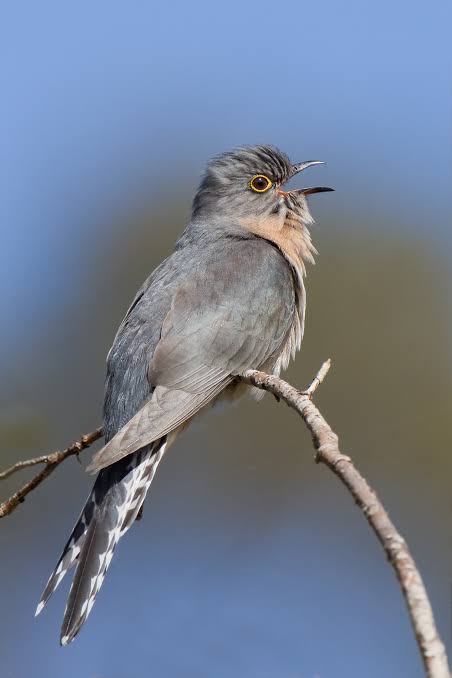Throughout the years, crows and vultures have gotten a bad reputation as the villains of the bird kingdom for their dietary practices and omens of doom, yet an even scarier evil exists and has somehow hidden under the radar from most people including myself –until now.
By sheer serendipity, I have recently discovered the tyranny of the seemingly innocent cuckoo bird after whom the famous cuckoo clock of our childhood cartoons is named. And trust me, there is nothing cute about it. In fact, their lifestyle can be described as nothing short of pure villainy. In a minute I will uncover the truth about these feathery terrorists, but before I do, a little background knowledge.
The cuckoo bird is a member of the family Cuculidae which encompasses thirty three genera. They are tree-dwelling or ground-dwelling birds which feed on insects, larvae and fruit mostly. Some common species are the roadrunner, the black-billed cuckoo, the common cuckoo, etc.
Some have black feathers to resemble ravens, while others come in splendidly brilliant shades of green and blue. Their average lifespan is four to eight years, and they can be found in every continent except Antarctica. Behaviour wise, they are often solitary band they have a unique means of processing their food which involves crushing it first against a hard surface such as a rock or a branch and then between the bony plates at the back of their mouths. A number of them build their own nests in trees or bushes, however many do not.
Here comes the evil part.
It has been discovered that 56 species of the subfamily Cuculinae exhibit a form of parenting known as brood parasitism, in which they do not parent at all. Instead they infest the nests of other unsuspecting bird species with their eggs. This is achieved by a variety of cunning mechanisms. One is the distraction strategy, in which the male cuckoo lures the mother of the target nest away so that the female cuckoo can quickly lay her eggs amongst her brood.
Another is the chuckling call produced by the female cuckoo which mimics that of the sparrowhawk, a predator of the reed warbler. Once distracted, the female cuckoo then lays her egg in the reed warbler’s nest. These eggs are often identical to the host’s, only the shells are thicker and stronger than that of the host, making them resistant to damage if the host should discover the intrusion and attempt to destroy the egg. There are other consequences for attempting to get rid of the parasite egg, but we’ll look at that later.Once the parasitic egg manages to escape detection it hatches much faster than the host eggs due to the mother’s ability to hold in the egg for 24 hours after it is ripe for laying, thus giving it a head start with internal incubation.
Do you know what the parasitic adopted firstborn of the litter then does? It chucks out the other eggs and younglings of the host species, sending them pummeling from high branches to a premature crushing death.
As if the forced adoption and infanticide –or should I say familicide –were not enough, this newly birthed devil chick pushes its unsuspecting host parent to cater to its feeding needs by emitting a rapid, bothersome begging call. Due to its larger size, the call of one cuckoo chick sounds like the cry of several host chicks, tricking the parent into thinking it has a nest full of hungry little ones. Therefore, it will bring back plenty of food. However as the cuckoo’s growth rate always surpasses that of the host species, even this effort will prove insufficient, and the parent will work at unnatural rates to feed the imposter’s ever growing appetite, until the parent dies of exhaustion.
The actual definition of sinister.
You may wonder why the host does not simply discard the parasitic youngling once it is born, if it cannot tell the difference whilst they are still eggs. Some cuckoo younglings do not kill all of their adopted siblings. Some are born smaller, or weaker than others. In these cases, the host may attempt to push out the intruder. Wrong move.
There is evidence that cuckoo adults retaliate against rejection of their eggs by attacking and destroying the host’s nest and eggs, thus blackmailing the host into raising their young or facing total destruction of its home and offspring. This is known as the mafia hypothesis as seen in the great spotted cuckoo species, and only verifies the fact that these creatures have criminal behaviour hard coded into their DNA.
Which leads me to a terrifying question. If pretense and murder are not traits learnt by these chicks who never get to so much as meet their parents but are rather innate, does that imply that violent, murderous or selfish behaviour might be a function of nature and not nurture in other species also? Does this lifestyle pattern in cuckoos suggest that criminal tendencies truly can be passed down genetically, regardless of environment?

Deep down, is there a little bit of cuckoo in all of us?
Opeolu Oreoluwa

6 comments
This is a beautiful piece, it has got me thinking !
Thank you, I’m glad it has.
Great article, felt like listening to a naturalist.
Lol, I saw what you did with the word play earlier. Thanks Muhammad.
Beautiful. Amazing!
Thanks a lot Uche.